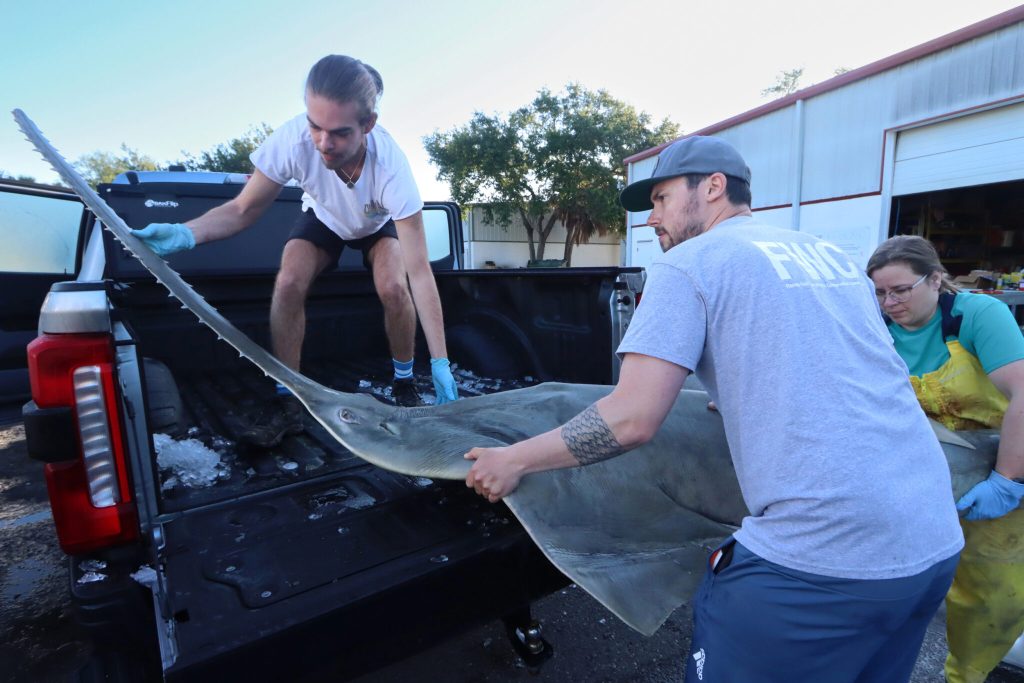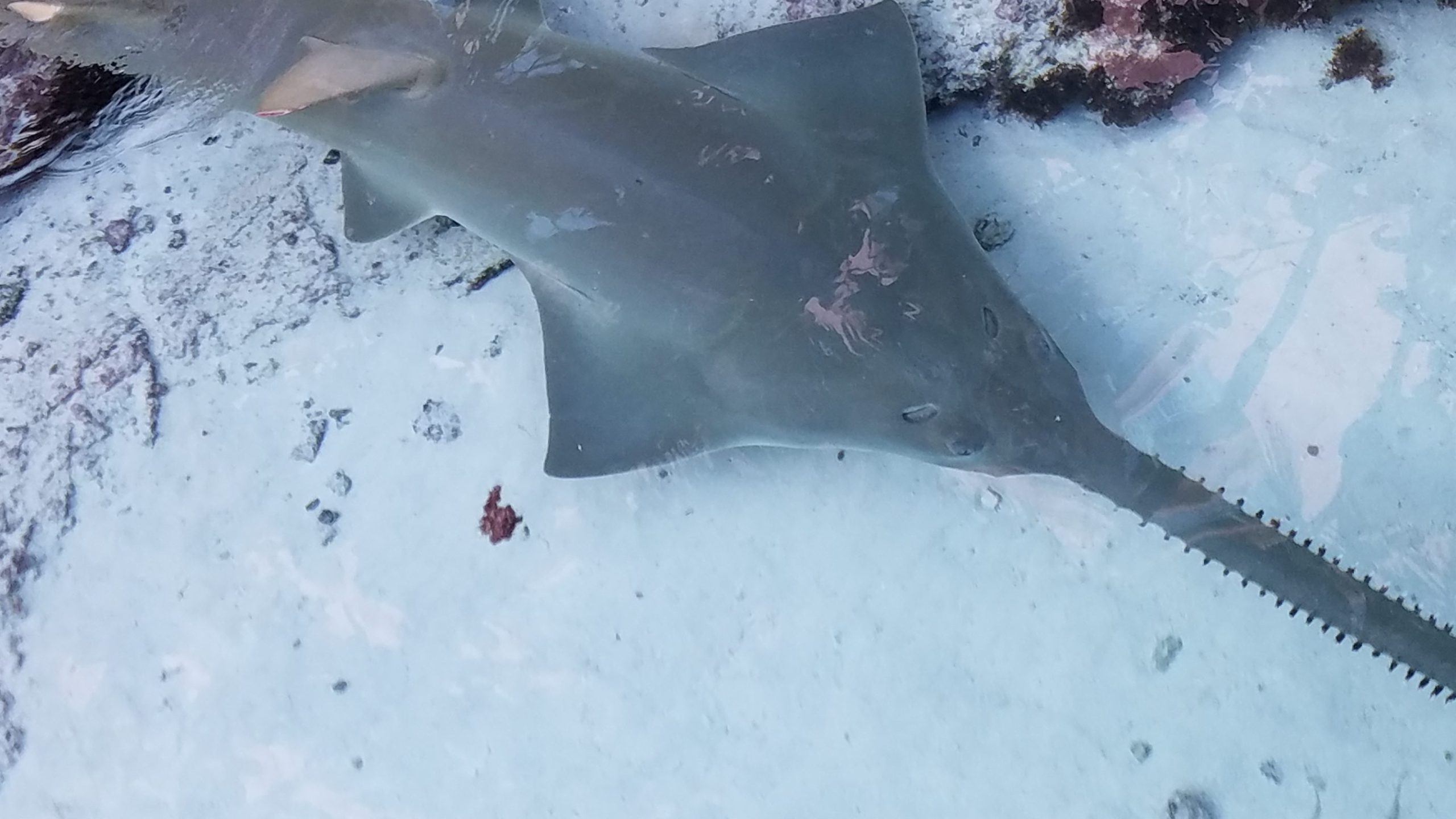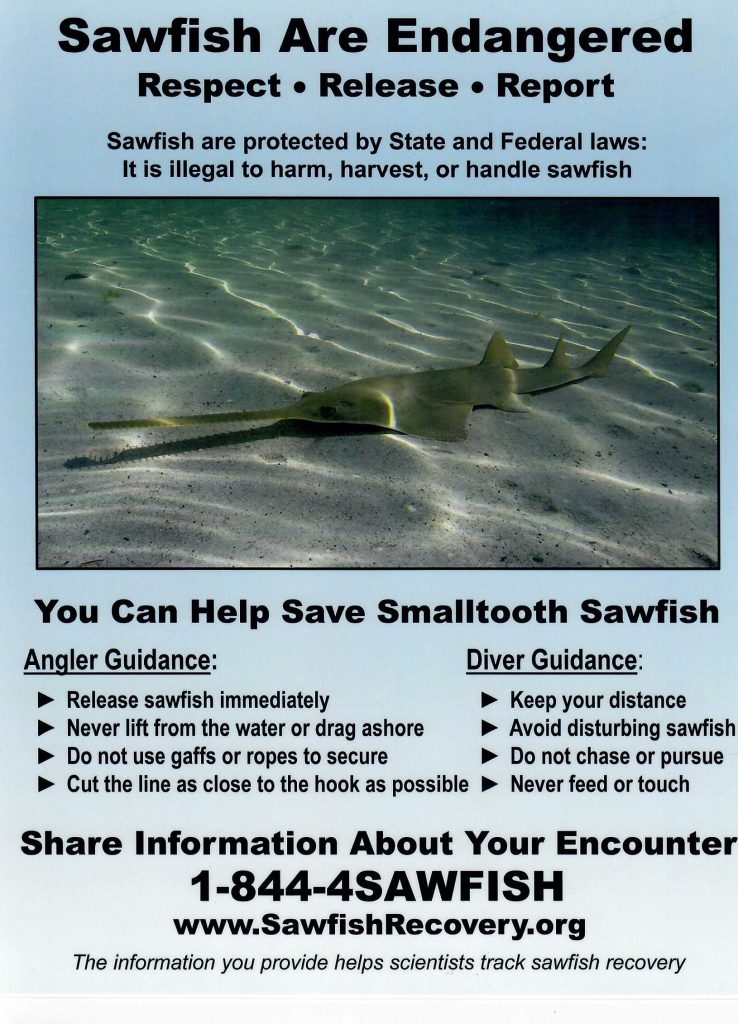An epidemic of spinning disease is killing these Critically Endangered animals in a horrifying way. I spoke to experts to help understand what’s going on and what’s being done to help.

A dead sawfish is unloaded by the Florida Fish and Wildlife Conservation Commission in preparation for a necropsy. Image courtesy Florida Fish and Wildlife Conservation Commission.
A transcript of my interviews, lightly edited for length and clarity, is presented below.
What exactly is a sawfish?
“Sawfish are rays, even though they look more like sharks,” said Stacia White, the Assistant Director of Husbandry for Ripley’s Aquarium and the AZA studbook keeper for sawfish. “What sets sawfish apart from other species of rays is the long rostrum located at the front of their head that looks like a saw. Along that rostrum are specialized teeth that project out from the sides that help the animal in hunting for prey and for defense.”

A photo of a captive sawfish. Photo credit: Tonya Wiley
“They look like a shark with a hedge trimmer for a nose,” said Tonya Wiley, President of Havenworth Coastal Consulting and the leader of the U.S. Smalltooth Sawfish Recovery Team. “There are five species of sawfishes worldwide, and only the smalltooth sawfish is currently found in U.S. waters.”
“Calling it a saw can be a little misleading, because they don’t use it like how a saw is used for woodworking,” said Dr. Gregg Poulakis, a fish biologist at the Florida Fish and Wildlife Conservation Commission’s Fish and Wildlife Research Institute. “They swing it very fast from side to side to stun schooling fishes, their primary food.” [WATCH A VIDEO OF THIS BEHAVIOR HERE]
Why are sawfish in trouble?
“Their saw is one of the features that led to the decline of this animal, as it can easily become entangled in a variety of fishing gear, which historically lead to high levels of bycatch mortality in several fisheries,” said Adam Brame, the sawfish recovery coordinator at NOAA Fisheries. “Habitat loss from coastal development remains an additional threat affecting their populations.”
“In the United States, Smalltooth sawfish were once found in coastal waters from Texas to North Carolina,” Tonya Wiley said. “However, fishing mortality and habitat loss led to dramatic reductions in both their numbers and range. Now they are regularly found only in southwest Florida, particularly in and around Everglades National Park.”
“Sawfish live in shallow coastal areas, estuaries and even in freshwater river systems,” Stacia White said. “These same areas on where people frequent the most for fishing, boating and recreation.”

What’s going on with the spinning? Do we know what causes it?
“Since November 2023 a variety of fish species have been reported as spinning and exhibiting abnormal swimming behaviors in the lower Florida Keys,” Adam Brame said. “To date, more than 50 species of fish have been affected. . In late January we began receiving reports of sawfish exhibiting abnormal swimming behaviors that included beaching themselves on shallow flats. Since that time, the Smalltooth Sawfish Recovery Implementation Team has received more than 175 unique reports of affected sawfish, including 44 confirmed mortalities (recovered carcasses).”
“Something similar is known in freshwater, a whirling disease caused by a parasite that affects trout and salmon,” Tonya Wiley said. “It’s been documented in saltwater before, in 1917, as well.”
“Part of our efforts includes characteriziing blood samples from healthy and sick fish, which will advance our knowledge of sawfish physiology in general and more specifically will help inform clinical care of rescued sawfish,” said Jennifer Wyffels, a research scientist at Ripley’s Aquarium. “It is important to recognize that just collecting data is not enough, organizing and sharing it ensures that all the experts involved in the sawfish rescue and recovery effort can evaluate the information from their unique perspectives to collectively try and understand what is killing these endangered fish.”
[Note: FWC Maintains a regularly updated online database tracking the state and scope of this event.]
What impact could this have on their populations?
“We’re unsure at this time how all these mortalityies will affect population viability and recovery,” Adam Brame said. “There are a lot of important questions we need to answer, espeically the longer this mortality event continues. This event has made clear how fragile an endangered species population can be.”
“This could have devastating consequences for the populations of this endangered species that is just now starting to show improvements after being listed on the Endangered Species Act for 20 years,” Tonya Wiley said.
What reactions have you had to this news?
“I have worked on sawfish for over 23 years, and this is the single most devastating event that has ever happened to this population,” Tonya Wiley said. “It has been emotionally, physically, and mentally exhausting, and we just couldn’t continue to watch these amazing and endangered animals die.”
“In December 2023, sawfish experts met to discuss 20 years of successful steps towards recovering the US population of smalltooth sawfish, and we were full of optimism moving forward,” said Adam Brame. “Then just a few months later, this unusual mortality event happened. To say it’s a been a roller coaster of emotions is an understatement.”
What is the plan to rescue and rehab sick sawfish?
“An unprecedented mortality event called for an unprecedented response,” Adam Brame said. “The plan was to rescue sawfish that had stranded on beaches and shallow flats, moving them to human care environments where we could monitor and provide veterinary care. While similar efforts have been made for marine mammals and sea turtles, this was the first attempt for a large coastal elasmobranch. Obviously transporting large fish that respire underwater is logistically challenging.”
“NOAA began reaching out for assistance and that put some wheels in motion,” Stacia White said. “Several aquariums compiled their expertise in handling, transportation, and husbandry for sawfishes to work out the complex logistics involved.”
“It’s heartbreaking that the first sawfish in rehabilitative care didn’t survive,” Tonya Wiley said. “We knew this was a possible outcome, but this rescue attempt still provided us with valuable information for next time. We’ll learn as much as we can and reveiw our procedures for future efforts. We respond to all calls, but so far have not been able to locate another live sawfish to attempt another rescue.”

In case you wondered how large of a truck you need to transport a sawfish…
image courtesy Mote Marine Laboratory and Aquarium.
How can people help?
“Unlike manatees, dolphins, and sea turtles which have established and funded rescue and rehab programs, this hasn’t been done before, so we didn’t have the funding in place,” Tonya Wiley said. “Funds are used for rescue, rehabilitation, necropsy, research, outreach and education, and hopefully returning animals to the wild. We need funds for food, medicine, and facilities for rehabbing sawfish; supplies, equipment, and facilities for rescue, rehab, and necropsy; collection, processing, and analysis of water and tissue samples; scientific equipment for monitoring sawfish after return to the wild; travel, food, and accommodations for essential personnel; fuel, drivers, and tolls for transport vehicles; materials for sawfish outreach. The outpouring of support so far has been heartening, we quickly raised over $40,000 to help uf get this effort off the grounds, but we will need to secure more funding. Donations are accepted at www.SawfishRecovery.org.”
“The public is encouraged to report distressed sawfish they see to (844) 4-SAWFISH (844-472-9347), sawfish@myfwc.com, or at www.SawfishRecovery.org,” Gregg Poulakis said.
Is there anything else you’d like to say?
“Reports of affected sawfish have slowed down during the last two weeks, but we don’t know if its because people have stopped reporting because the weather was bad and they’re not out on the water, or if there’s been a change,” Tonya Wiley said. “But we are not ready to relax and assume that this event is over.”
